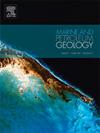Coalification patterns and thermal-depositional history of the Upper Cretaceous-Paleogene coal in the Eastern Cordillera Basin, Colombian Andes
IF 3.7
2区 地球科学
Q1 GEOSCIENCES, MULTIDISCIPLINARY
引用次数: 0
Abstract
Understanding coalification patterns and thermal history in coal-bearing sequences is critical for basin analysis. In most basins, coalification is linked to maximum burial temperatures. However, syn/post-deformational thermal overprinting may occur in tectonically active settings. This study evaluates the coalification history of the Cretaceous-Paleogene Guaduas Formation in the Colombian Andes, a 1000 m thick sequence with extensive coal seams and significant gas generation potential. A comprehensive methodology was applied, including a geological survey, open system pyrolysis (Hawk), organic petrology, and thermal history modeling of 118 coal samples. The gas content was also determined using the desorption method. Total Organic Carbon (TOC) varied from 19.29 wt% to 82.73 wt%, with Tmax values between 430 °C and 494 °C. The random vitrinite reflectance (VRr%) ranged from 0.46 % to 1.65 %, indicating coal rank from Sub-bituminous A to Bituminous A (ISO 11760 classification). Paleotemperatures ranged from 72.5 °C to 175.9 °C, with gas content varying between 6.01 ft3/ton and 55.23 ft3/ton. Paleogeothermal gradients ranged from 63.4 °C/km to 94.9 °C/km. Coal rank generally increases with depth, highlighting burial as the primary coalification driver. However, variations in VRr% within individual seams suggest irregular coalification linked to multiple deformation phases. An increase in paleotemperature toward the northern sector correlates with enhanced tectonic activity. Burial modeling indicates over 4100 m of sedimentary overburden, followed by significant Cenozoic erosion after the Andean uplift. The organic matter (type II-III) and the combined influence of burial and tectonic processes played a fundamental role in organic matter maturation and the development of gas generation potential.
哥伦比亚安第斯山脉东部科迪勒拉盆地上白垩统—古近系煤的成煤模式与热沉积史
了解含煤层序的成煤模式和热历史对盆地分析至关重要。在大多数盆地中,煤化作用与最高埋藏温度有关。然而,同步/变形后热套印可能发生在构造活跃的环境中。本研究评价了哥伦比亚安第斯山脉白垩系-古近系瓜多瓦斯组的煤化史,这是一个厚1000 m的层序,煤层分布广泛,天然气潜力巨大。采用综合方法,包括地质调查、开放系统热解(Hawk)、有机岩石学和118个煤样的热历史建模。用解吸法测定了气体含量。总有机碳(TOC)在19.29 ~ 82.73 wt%之间变化,Tmax值在430 ~ 494℃之间。随机镜质组反射率(VRr%)范围为0.46% ~ 1.65%,煤级为亚烟煤A ~烟煤A (ISO 11760分级)。古地温为72.5 ~ 175.9℃,含气量为6.01 ~ 55.23 ft3/t。古地温梯度范围为63.4 ~ 94.9℃/km。煤阶一般随深度增加而增加,突出表明埋藏是主要的煤化驱动因素。然而,在单个煤层中VRr%的变化表明与多个变形阶段有关的不规则煤化作用。北段古地温升高与构造活动增强有关。埋藏模式显示超过4100 m的沉积覆盖层,随后是安第斯隆起后明显的新生代侵蚀。有机质(II-III型)以及埋藏和构造作用的共同影响对有机质成熟和生气潜力的开发起着基础性作用。
本文章由计算机程序翻译,如有差异,请以英文原文为准。
求助全文
约1分钟内获得全文
求助全文
来源期刊

Marine and Petroleum Geology
地学-地球科学综合
CiteScore
8.80
自引率
14.30%
发文量
475
审稿时长
63 days
期刊介绍:
Marine and Petroleum Geology is the pre-eminent international forum for the exchange of multidisciplinary concepts, interpretations and techniques for all concerned with marine and petroleum geology in industry, government and academia. Rapid bimonthly publication allows early communications of papers or short communications to the geoscience community.
Marine and Petroleum Geology is essential reading for geologists, geophysicists and explorationists in industry, government and academia working in the following areas: marine geology; basin analysis and evaluation; organic geochemistry; reserve/resource estimation; seismic stratigraphy; thermal models of basic evolution; sedimentary geology; continental margins; geophysical interpretation; structural geology/tectonics; formation evaluation techniques; well logging.
 求助内容:
求助内容: 应助结果提醒方式:
应助结果提醒方式:


